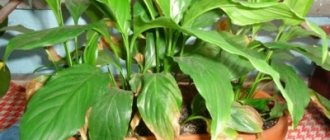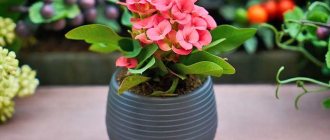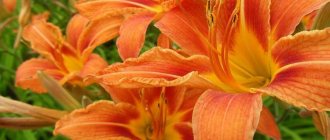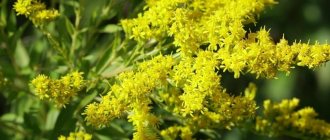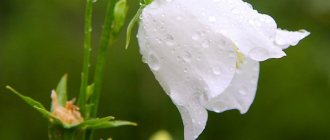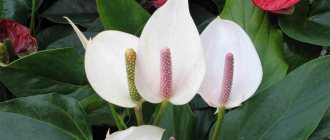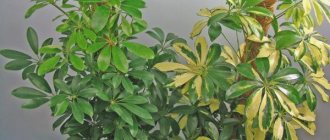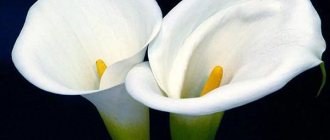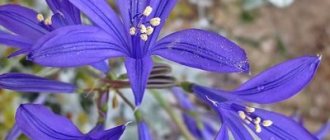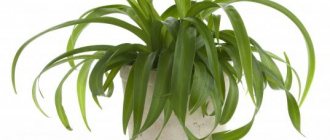The most famous, the most useful, the most unpretentious and, oddly enough, the most annoying - which green pet can you say that about? Of course, this is chlorophytum - a houseplant that can be found everywhere.
Even during the times of the Soviet Union, chlorophytum gained unprecedented popularity: it was grown in apartments, schools, clinics, and stores, that is, almost everywhere. Of course, at that time people were not spoiled by exotic home flowers, but still this is not the only reason for the widespread distribution of chlorophytum. The fact is that this plant combines both decorative properties and various useful qualities, which you will learn about by reading the article. Subsequently, the popularity of chlorophytum faded, and the minds of amateur plant growers were occupied by new fancy flowers.
[!] Recently, due to the popularity of a healthy lifestyle, interest in chlorophytum has begun to revive again.
Chlorophytum, whose Latin name is Chlorophytum, is a representative of the Liliaceae family (Latin Liliaceae), according to some scientists, or the Asparagus (Latin Asparagaceae) and Agave (Latin Agavoideae) families, according to others.
In the wild, chlorophytum can be found in the tropical rainforests of South America, Africa and Australia. The perennial has a particular preference for river banks with volcanic or sedimentary soils. The special structure of the roots with tuberous thickenings that accumulate moisture allows the plant to survive dry periods, which often occur in the tropics and subtropics.
In its homeland, Africa, chlorophytum is very popular, both wild and cultivated. Among the Nguni tribes, the plant is used both for medicinal purposes (especially for pregnant women) and as an amulet to protect mother and child. Chlorophytum is even used on a national scale: the perennial is planted on steep embankments and slopes to combat landslides and soil erosion.
The name comes from a combination of two Greek words - “chloros” (greenish-yellow, green) and “phyton” (plant), so in Greek, chlorophytum is simply “green plant”. Of course, this word form is not entirely correct, because many varieties of perennials are not only green, but also multi-colored: with cream, white and even orange shades. Chlorophytum was first widely studied, described and named in 1794 by the Swedish botanist Carl Peter Thunberg during an expedition to South Africa.
Chlorophytum is a representative of perennial evergreen herbs. In the natural environment, it reaches up to 1 m in height and in diameter; in home growing conditions, the maximum dimensions are about 40 cm. Long lanceolate leaves hang freely down, the stems are thin and curved, and a leaf rosette with aerial roots is formed at the ends of the stems. The flowers are small, white, collected in loose inflorescences of five to six pieces. The flowering of chlorophytum is not of decorative interest.
Peculiarities
Chlorophytum is native to South Africa and is an epiphyte, meaning it grows on the trunks of other trees. Chlorophytum has no real roots - only rhizomes in which it actively stores moisture. Therefore, it tolerates long dry periods and lack of regular watering well.
The leaf blades of Chlorophytum are narrow, long, light green, sometimes with white or yellow stripes. The bush is low, up to 60 cm in diameter. With proper watering and favorable conditions, soon after planting numerous airy tendrils begin to hang from the pot. At their ends new leaf rosettes appear, which are called “babies”. With their help, the flower multiplies and also evaporates excess moisture more intensively. Over time, new tendrils grow from the “babies”, and this is how green cascades are formed, for which this plant is so valued.
Chlorophytum flowers are inconspicuous - small, single, white, with bright yellow stamens.
Description of the plant
Chlorophytum belongs to the asparagus family and originates from South Africa. This is a popular type of herbaceous plant that often decorates window sills in homes, offices, and shops. Found naturally in Africa, Asia, and America.
This is interesting! The genus name Chlorophytum means "green plant" in Latin. Because of its characteristic appearance, long peduncles and stems with daughter rosettes, in English-speaking countries it is called a “spider plant”.
Description of the species:
- This herbaceous plant reaches a height and diameter of 45 centimeters, so it is ideal for landscaping a house or apartment.
- The leaves are drooping, long, narrow, light green, can reach a length of 50 centimeters and a width of 2.5 centimeters. Commercially available varieties often have leaf blades with a pattern of white or yellow stripes.
- stems are thin, long, hang in an arched manner, and flowers form at their ends.
- The flowers are inconspicuous, white, five-petaled, with protruding stamens. In place of the flowers, daughter rosettes are formed - young plants consisting of a leaf rosette and aerial roots that can be planted in pots.
One of the main reasons for the great interest in this species is its ease of care and high air purification ability. The plant will withstand more care errors than other potted flowers. This long-lived plant can grow for many years if provided with a large pot and fresh substrate every 3-4 years.
The indoor chlorophytum flower looks great in hanging pots, on a cabinet or trellis. Also looks good in a pot on a windowsill or among other potted plants in a flower bed. The plant is good for health - it can purify the air from formaldehyde, xylene, carbon monoxide, acetone, ammonia and heavy metals.
Varieties
In total, there are about 200 species of chlorophytum in nature. Their names usually reflect the characteristics of their leaf blades.
- Crested or komosum. The most famous type of chlorophytum, with long and narrow emerald leaves. In the center of each leaf blade there is one bright white wide stripe or several narrow stripes. When a flower shoots out an 80-100 cm arrow, 5-7 white flowers appear on it. After they fade, a “baby” appears at the end of the airy whisker.
- Curly (Bonnie). This variety of chlorophytum leaves reach 60 cm in length and no more than 3 cm in width. The leaves form dense basal rosettes, from which short, numerous flower stalks are produced. This species does not form long airy whiskers with “babies”, so its reproduction occurs by dividing the mother bush.
- Cape. This variety is very similar in appearance to Chlorophytum curly, but its leaves are much longer - from 90 to 100 cm. But, like Bonnie, it does not produce flower stalks and does not form “babies”. Reproduction occurs by dividing the mother bush.
- Winged or orange (orchid star). Only an experienced gardener will recognize this plant as chlorophytum, since it is completely different from related species. Its leaf blades are wide, elliptical in shape, pointed at the ends. It reaches a height of 30-40 cm. The leaf petioles are fleshy and bright orange, which is why this species got its name. The central vein, as well as the warp of the leaf blades of young leaves, are orange. Over time, the leaves, with the exception of the central part, become completely green. The peduncles are short, the flowers are collected in inflorescences resembling a cob. “Children” are formed at the base of the mother bush.
In order for the flower to always retain its rich orange color, you should cut off the extra “babies” and flower stalks, on which the plant consumes water and nutrients.
- Variegated . This variety was bred by breeders. It is distinguished by leaves with stripes of white, yellow and cream tones. Forms long airy mustaches with “babies”.
- Laxum . The rarest type of chlorophytum. Forms a dense basal rosette of leaves, but does not form airy mustaches. Unlike other species, it reproduces well by seeds. The leaves are narrow - no more than 1.5 cm, framed along the edges with white stripes.
Plant species
Photos of wild species of chlorophytum would not fit into any article - there are almost 200 of them. But these plants are of little interest to us. Give us indoor ones, beautiful and not picky. There are much fewer of them - less than ten species.
Crested
A perennial with bright leaves 40 to 50 cm long.
The species got its name due to the fact that it grows a very large number of leaves. They are curved in an arc.
Peduncles appear from.
The base shade of crested chlorophytum is bright green (this is exactly what we grew in our class). But modern breeders have done a lot of magic on the plant, and now we have many varieties with striped, multi-colored leaves. I will show their photos below.
Bonnie (curly)
The leaves of this species are not only shorter than those of crested chlorophytum, but also slightly curled - instead of provocatively sticking out to the sides, they wrap around the pot.
Foliage shade: on the sides the leaf blade is bright green, in the center there is a noticeable white stripe.
Such bushes also form a long peduncle and grow children at its end.
Cape
The leaves of this plant are still monochromatic, light green. They are lanceolate, that is, long, elongated and sharp at the end (“grass”, in a word). The length of such a leaf plate reaches 60 cm. They are wider than those of previous types.
Some gardeners find this bush a bit boring. But if you plant several varieties of variegated (multi-colored) chlorophytum and one Cape bush in one long container or large pot, you will get a composition that is delightful in its contrast.
This plant does not grow tendrils (or children). A short peduncle appears from a dense leaf rosette, on which small small flowers bloom.
Cape chlorophytum reproduces mainly by dividing a mature bush.
Orange (winged, orchid star)
You can’t even immediately tell from this plant that it is chlorophytum: orange, fleshy petioles, dark green oval leaves on them, a spike-shaped inflorescence in the shape of a cob grows on a short peduncle.
The height of such a bush is from 30 to 40 cm.
Another difference between this species and the others: it is more fastidious in care. Let's say a bush needs to be watered often, the water should never be cold, and water should never get into the leaf rosette.
It is also known that when blooming, such a bush “sheds” - the colors of its leaves become less bright. Therefore, some gardeners immediately remove the peduncle, not wanting to spoil their decorative foliage plant with this “misunderstanding.”
New varieties
Relatively recently, breeders have developed new varieties of Chlorophytum crested, which are very popular among gardeners:
- Variegatum - this variety has lighter stripes along the edges of each leaf;
- Vittatum - this chlorophytum is distinguished by a white stripe in the center of the leaf;
- Mboyeti - this variety is characterized by the dark emerald color of the leaves with wavy edges;
- Atlantic - this variety has thin, delicate, slightly curly leaves;
- Ocean - the leaf blades of this variety are not as long as others, and are framed at the edges with white stripes;
- Maculatum - differs from other varieties in large leaves with yellow stripes;
- Curty Locks is a chlorophytum with broad, green and white striped leaves that curl in spirals.
The most popular varieties
Basically, we can be pampered with crested varieties, and less often - other types of chlorophytum.
Vitatum
Variety of crested chlorophytum.
The leaves of the variety are green, but with a white stripe down the center of the leaf, running along its entire length. Moreover, this stripe can be either ideal, as if drawn under a ruler, or vague, gradually expanding.
Variegata
But this crested plant is colored exactly the opposite: the middle of its leaves is lush green, and the sides are light, even a little silver.
Ocean
It is similar to the previous variety (also green leaves with white sides), but this tufted bush has leaves arranged in a spiral. Although in fact, this is clearly visible only on a young, “skinny” plant, and only if you look closely.
Laxum
Another crested chlorophytum with green leaves edged with white. This time they grow in the shape of a fan (and this is also not very noticeable).
Maculatum
The last variety of crested chlorophytum in this list, it is also the brightest and most unusual: its longitudinal stripe (and quite wide) is colored yellow, and the leaves on the sides are green.
Green Orange
The most popular variety of winged chlorophytum.
The bush has pronounced differences in its appearance: noticeable orange petioles and dark shiny leaves. Green Orange differs from other winged chlorophytums in having longer petioles, but at the same time the compact size of the bush (30 cm).
Fire Flash
Another successful winged chlorophytum.
It differs from the previous variety in having lighter petioles.
It can also be called a sissy - for example, such a flowerpot does not like bright light, preferring partial shade, and the soil in the pot of this plant should never dry out completely (although such chlorophytum will not grow in a puddle either).
Home care rules
Chlorophytum is so loved by many gardeners because it is completely unpretentious in care. To always maintain a neat and attractive appearance of a flower, it is enough to follow simple conditions for its maintenance.
- Watering. It is better to water the flower with settled water at room temperature (or slightly cooler) as the soil dries. However, if the flower is left for 1-2 weeks without watering, it will not die. The leaves may turn pale and lose turgor, but after watering their decorative qualities will be restored. In addition to regular watering, chlorophytum needs to be sprayed with water at least once every 2 weeks and the leaves must be wiped from dust with a damp cloth.
You can also wash the flower in a low-pressure shower. Excessive moisture will not harm it.
- Lighting. Chlorophytum is classified as a shade-tolerant plant, so it is often placed on cabinets, refrigerators and other places where direct sunlight does not reach. Excessive lighting is harmful to the flower; it leads to wilting and yellowing of the leaves. But if you place a flower on the windows of the north side of the apartment, it will feel good.
- Temperature conditions. Chlorophytum is not particularly sensitive to room temperature and its changes. As with many indoor plants, prolonged exposure to temperatures below +16 degrees can be detrimental to it. But in general, it has a very wide climatic comfort zone, and it grows well at temperatures from 20-22 to 30-35 degrees Celsius.
- Soil and fertilizing. This plant is completely unpretentious to the soil in its pot. It feels good both in a light substrate with a high sand content, and in soil rich in organic compounds, peat and humus. Chlorophytum is particularly insensitive to acidity, but excessive acidification of the soil can negatively affect its health.
How to properly care for chlorophytum: home conditions
Chlorophytum is an unpretentious house flower, so beginner gardeners can grow it. And although it forgives its owner for forgetfulness and inattention in care, it requires minimal care. The best option would be to grow exotic plants in hanging flowerpots, and it is also important to protect them from temperature changes and drafts.
The main principle that must be observed when thinking about how to properly care for chlorophytum at home is moderation and restraint in everything. The basic conditions of detention are not particularly difficult and are described below.
The best lighting is diffused sunlight. You can choose any location, as long as it is not too dark; In summer, chlorophytum can be exposed to the air. It grows well on balconies and covered terraces. However, you need to ensure that the place where the flower will be located is protected from rain and wind.
Another interesting feature that needs to be taken into account when choosing conditions for keeping chlorophytum is that if it is kept in a shady place, the bright color of the foliage in variegated species will be lost. If direct sunlight is directed at the flower for a short time every day, this will not harm it, and in the sun the leaves of the plant will only become brighter.
It must be said that chlorophytum can exist in conditions of exclusively artificial lighting - it successfully grows, develops and performs a decorative function. Paradoxically, it is in enclosed spaces that the plant does its best job of purifying the air.
Optimal temperature: room temperature, 18-20 degrees. However, it withstands drops down to 8 degrees well. The minimum short-term temperature is 2 degrees, and if the thermometer shows more than 32 degrees Celsius, then the tips of the leaves of chlorophytum dry out.
The first thing to do in such a situation is to place it in a shady place and remove the darkened areas of the leaves with ordinary garden shears.
The growing season lasts from spring to autumn, and all this time the flower needs plenty of moisture. And if watering when growing a chlorophytum flower should be regular, and during the growing season it is not advisable to allow the substrate to dry out completely, then in winter it is enough to water it only once every 7-10 days.
A very important point in caring for any type of chlorophytum flower at home is the timely removal of moisture from the flowerpot, so as not to create preconditions for its stagnation. This is why drainage and choosing the right flowerpot with holes in the bottom are so important.
It is difficult to find a more famous house flower than chlorophytum. In the 60-70s of the 20th century, it was so popular in our country that it was found in almost every apartment. And they are still actively used for landscaping in schools, kindergartens, hospitals and other institutions, because in addition to excellent decorative qualities, it is one of the most unpretentious indoor plants. Even novice gardeners can grow chlorophytum.
Reproduction
It is possible to propagate chlorophytum in different ways.
- "Children." Chlorophytum mainly reproduces by small bushes formed on airy tendrils. Usually these bushes are called “babies”. For rooting, it is enough to cut off even a very small “baby” from the airy tendril and place it in moist soil. You can place it in water and wait for the young rhizomes to appear, and then transfer it to the ground.
It is best to plant “babies” at the end of winter - beginning of spring, before the start of the period of active plant growth.
- Seeds. Propagation by seeds is not very popular among gardeners, since this procedure is troublesome, and the germination rate of seeds is quite low - no more than 30 percent. It is better to plant in the spring, when there is active daylight. For better germination, seeds are soaked in gauze a day before planting. Sand and peat soil is prepared in pots, into which planting material is placed to a depth of 5-7 mm. The soil is moistened and covered with film.
Before emergence, greenhouses are kept in a slightly dark place at a temperature of 22-25 degrees Celsius. Crops must be ventilated and moistened daily by spraying to prevent the seeds from being washed out. After 4-6 weeks, single shoots appear.
Seedlings should be opened gradually, increasing the time spent in the light every day. When the seedlings have 2-3 true leaves, they are planted in separate small pots.
- Dividing the bush. Chlorophytum should be divided during spring replanting if the rosette of the mother bush grows excessively. The bush removed from the pot is divided into four equal parts with a sharp knife, the cut areas are sprinkled with charcoal and planted in separate pots.
Growing in water
Rooting plants in water can be a convenient way to propagate chlorophytum without loss. But this is not the best option to preserve these plants for a long time. They like well-drained substrate. In addition, in the future, plants will need more nutrients than regular water can provide.
Although you can purchase specially prepared fertilizer mixtures for hydroponic gardening, they are not ideal for caring for these plants. Chlorophytums growing in water on a constant basis will not bloom and will live a short life.
Diseases and pests
Chlorophytum is resistant to most diseases and pathogenic insects that attack indoor plants. However, sometimes the flower loses its decorative qualities and looks sick. This can happen for several reasons.
- Excessive moisture and lack of light. These factors lead to rotting of the root system. With this disease, chlorophytum looks wilted, although the soil in the pot is moist. And sometimes brown stripes appear in the middle of the leaves. To save the flower, it needs to be replanted, while cutting off the rotten roots, treating the cut areas with charcoal. After transplantation, the flower should be moved to a more illuminated place.
- Dry air, excess moisture and stagnant water in the pan or excessive amounts of nitrates in the soil. The flower communicates these negative factors with the drying tips of its leaves. To get rid of this, the flower should be replanted, the soil should be changed to a lighter one, and a container of water should be placed near the pot to humidify the air.
- Lack of light and nutrients. At the same time, in striped varieties of the flower, the stripes fade, and the color of the leaves becomes faded. In this case, you should add fertilizer to the soil, and also change the location of the flower to a sunnier one.
- Lack of moisture and dry air. In the hot season, this leads to the fact that the leaves of the plant begin to dry at the roots. Getting rid of this disease is very simple - increase the frequency of watering and spraying.
- Excessive lighting. It leads to the formation of brown spots on the leaves. To prevent this from happening, just move the pot to a more shaded place.
- Rare insects that attack chlorophytum are aphids, nematodes, thrips and mealyworms. You can get rid of them using a folk remedy - gently wipe the leaf blades with a cloth soaked in soapy water, then rinse.
How to propagate chlorophytum in water
If the maintenance conditions are met, the plants quickly form arrows with buds, which, after pollination, turn into shoots with aerial roots. Therefore, the propagation of chlorophytum usually does not cause problems.
You can root small sprouts by planting them in a plastic cup or bowl with filtered or distilled water. Simply place them in liquid so that it covers the roots without touching the leaves. Then the container with the shoots should be placed in a place with indirect lighting. The water should be changed daily to prevent the growth of bacteria and mold.
Once the seedlings have good roots, it is time to transfer them to a pot, hanging basket or container with appropriate growing soil.
Beneficial features
It is no coincidence that chlorophytum is one of the most popular houseplants. In addition to its excellent decorative qualities, it also has some useful properties.
- Air purification. This flower absorbs not only carbon dioxide more effectively than many others, but also assimilates carbon monoxide, acetone vapor, formaldehyde and nicotine in its leaves. Therefore, it is highly recommended to keep it in the kitchen and in rooms often smoky with tobacco smoke, as well as where there is a lot of furniture made of chipboard, since it emits formaldehyde in small doses.
- Air humidification. Chlorophytum intensively collects and evaporates moisture, therefore it is a natural air humidifier. This is very useful for people with various pulmonary diseases and for maintaining youthful skin. According to statistics, one flower humidifies the air in an area of 2 square meters around itself.
- "Family happiness". According to Feng Shui, this flower is good to keep in the house to maintain a calm family environment and bring harmony to your personal life.
- Good for pets. Owners of cats and small dogs sometimes grow chlorophytum for their pets, as this flower helps cleanse the stomach, is absolutely harmless to them, and also contains some useful vitamins.
For the beneficial properties, care and propagation of chloroitum, see below.
General characteristics of chlorophytum
Most adults have seen this flowerpot more than once. About 20-30 years ago, every self-respecting school and clinic was decorated with chlorophytum. What can I say, in many such establishments these unpretentious and, most importantly, indestructible plants are still happily green.
Read also: Metal swing gates with a wicket made of corrugated sheets
Chlorophytum is native to southern Africa.
The flowerpot has bright leaves, and also blooms: in spring and summer (and sometimes even in autumn or winter), it grows long “antennae”, which are later covered with small white, star-like flowers.
Not everyone considers such a flower the height of perfection. But cutting off the tendrils without allowing the plant to “go wild” is a mistake - when the flowers fade, chlorophytum children will form here. Hung with offspring, chlorophytum looks even more elegant. In addition, over time, the babies can be separated and planted in pots; the survival rate of the babies is simply crazy.
There are many reasons to grow such a flowerpot.
- It is simply beautiful and fits well into the concept of a “green”, living interior.
- It purifies and humidifies the air in the room (doctors talk about the antiseptic effect of the plant - it kills bacteria floating in the air, so it is especially valued during quarantine periods). In addition, the chlorophytum bush exudes phytoncides that are beneficial to our health, eliminating particles of carbon monoxide and tobacco smoke, as well as formaldehyde, which new furniture and wallpaper generously share with us.
- Beliefs say that chlorophytum attracts prosperity and family happiness into the house.
The plant has no stem. Immediately from the roots, a rosette of dense, sharp-edged leaves, narrow and with a smooth surface, emerges. The length of the leaves can be up to 50 cm. The most interesting thing about chlorophytum is its dense, massive rhizome, consisting not only of roots, but also of small tubers. This is where the flowerpot accumulates moisture, which helps it survive for a long time without watering.
Choosing chlorophytum: description of species and varieties with photos
Greetings, dear flower growers! I don’t know about you, but along with beautifully flowering house plants, I really love decorative foliage plants. And here my favorite is chlorophytum, the types and varieties with photos of which will be given in the article.
Why does he attract me? Unpretentiousness, decorativeness, variety of leaf colors and some special modest beauty.
Let's not forget about the beneficial properties of the plant, its ability to purify the air, moisturize it, creating a very comfortable microclimate in the room. And I really hope that many of those who were somewhat skeptical about this flower will change their minds and definitely choose a variety to grow.
Rooting in soil
Reproduction in the ground occurs naturally and very simply. Chlorophytums themselves create many shoots with white, star-shaped flowers that become small plants hanging from the mother.
In the wild, these little babies come into contact with the soil, take root and detach themselves from the main bush. In the photo, chlorophytum laxum can often be seen with hanging arrows, on which there are small white flowers.
This plant reproduces quickly if it grows in good conditions. It is easy to reproduce this natural process. It is enough to cut small plants from the ends of the shoots with sharp scissors and bury their roots in loose soil.
Types of chlorophytum: photos and names
Chlorophytum crested
The most popular and widespread is Chlorophytum crested.
Very often it is called bunched, and all because the perennial has a shortened stem, and long, arched leaves are collected in small bunches. The leaves are xiphoid, green, and may have stripes of different shades.
Externally, the plant looks like a lush bush, which during the flowering period is covered with numerous shoots with tiny white flowers-stars and rosettes.
Feature of the species: several shoots bloom at the same time, many rosettes are formed, which hang down and are very similar to tufts.
This species is valued for its ability to quickly reproduce, the spectacular appearance of the flower, and very easy care.
At the same time, you can always plant chlorophytum crested in different varieties:
- Variegatum - this plant has white stripes on its long (up to 40 cm) leaves (in the middle, along the edges).
- Vittatum – green leaves have a whitish stripe class=”aligncenter” width=”560″ height=”370″[/img]
- Mandainum - a stripe in the center of yellow color.
If you want to plant more spectacular plants, then we advise you to pay attention to the Bonnie variety. The leaves of this chlorophytum are not only narrow and long, but also wavy.
But the plant of the Curty Locks variety has spiral-shaped curly leaves, which makes the bush very unusual and original.
One of the new varieties with the interesting name Ocean, which is distinguished by its compactness and beautiful green leaves with yellow stripes.
IMPORTANT! If chlorophytum grows in unsuitable conditions for it, then the stripes on its leaves may disappear or change color.
But in the Bonnie variety, the white stripes do not change color and do not disappear.
Variegated and curly species and varieties of chlorophytum look very attractive, so you should pay attention to them and use them for interior decoration.
Chlorophytum cape
This species has a larger rosette and can reach a height of 70-80 cm.
The leaves of the Cape chlorophytum are linear, collected in a rosette, up to 60 cm long. The leaf width is up to 3 cm, the width is smaller at the tips and base, and there is a small groove on the top of the surface. Color – light green, glossy.
This plant also produces shoots with white flowers collected in panicles. But unlike its brother, Chlorophytum crested, this species does not form rosettes after flowering, and the flower stalks are short.
It can only be propagated by dividing the bush.
This species, of course, is inferior in decorativeness to the tufted chlorophytum with its magnificent hanging cascades of rosettes, which is why it is not found so often in interiors.
But with good care and regular abundant watering, a powerful bush with very beautiful leaves is formed, so this type of plant also has its connoisseurs.
Chlorophytum winged
Another type of chlorophytum, which bears little resemblance to previous plants.
It has large lanceolate leaves on long petioles and reaches a height of approximately 30-40 cm.
Feature of the species: the presence of fleshy petioles of pink, orange, brown with a red tint.
Chlorophytum winged has short flower stalks that, when ripe, resemble small ears of corn.
Its second name is orchid star.
An excellent result is obtained by propagating this chlorophytum with seeds, and you can get them yourself, leaving the flower stalks until they are completely ripe.
It is this species that includes the modern varieties of chlorophytum, which are very popular among gardeners: Green Orange and
- Green Orange (Green Orange or Green Orange)
- Fire Flash
What does orange chlorophytum look like? In these varieties, leaves grow from the center of the rosette; over time, side shoots may appear in the axils. Young chlorophytums have pinkish petioles and veins on the leaves; later they become bright orange. This contrast of colors - green and orange - gives the plant an unusually attractive and spectacular appearance. It seems that in the middle of a beautiful and powerful green rosette of leaves there is a fire burning.
IMPORTANT! To ensure that the petioles and veins do not lose their color intensity and are bright, it is recommended to remove the lateral shoots of the chlorophytum, as well as the peduncles.
Like all types of chlorophytums, orange beauties do not tolerate direct sunlight, so they need to be placed in places with diffused lighting.
Chlorophytum Laxum
This variety is not found very often, so only the most avid flower growers and chlorophytum lovers can see it.
The plant has narrow and small drooping leaves, the color is green, with a small white stripe along the edges.
Over time, a powerful large basal rosette is formed.
Striped Laxum produces shoots-peduncles, the inflorescences look like small spikelets. It does not form rosettes, following the example of Chlorophytum crested, and reproduces by dividing the bush and by seeds.
Perhaps you already have chlorophytums growing at home, and the description of the plants will allow you to determine their type.
Plants similar to chlorophytum
Quite often you can find ornamental plants that resemble chlorophytum in appearance and are just as easy to care for.
| Name | Botanical description | Features of flowering | Advantages and disadvantages |
| Billbergia | Forms a long tubular rosette of hard leathery, single-colored or variegated, narrow and elongated leaves covered with medium-sized scales | Attractive flowers with bright petals | Beautiful flowering, highly decorative, low maintenance |
| Ophiopogon | Leaves are sessile, linear or narrowly lanceolate, up to 20 cm long. The color is most often purple | The inflorescences are short, spike-shaped, with attractive small flowers of white or purple color. | Fairly high decorative value and good shade tolerance |
| Aspidistra | It has an underground creeping rhizome, dark green glossy leaves on long broad oval petioles | Flowers are sessile, not particularly attractive, perianths are brown-violet | Unpretentiousness, durability and good shade tolerance |
| Beaucarnea | Single-stemmed or weakly branched, slow-growing evergreen tree plant. Due to the shape of the trunk, which resembles a bottle, it is also called “elephant’s foot” and “bottle tree.” | Flowers green-white, numerous, small | |
| Narrow furrow (Stenotaphrum) | A perennial low plant with creeping above-ground shoots rooting at the nodes | Inflorescences are spike-shaped, relatively attractive | A very promising and popular lawn plant |
| Arundinaria | It has belt-shaped, hard leaves of unusual color adjacent to the beginning of the stem. Also called "house bamboo" | Inflorescences racemose or paniculate, with small flowers | A spectacular ornamental plant that forms a beautiful lush bush |
It should be remembered that almost all heat-loving indoor crops need sufficient lighting, but some of them cannot tolerate direct sunlight.
What you need to know about growing chlorophytums
Chlorophytum has earned the reputation of an unpretentious plant, and this is why many gardeners value it. But even such an undemanding flower needs proper care.
The rules are very simple, but if you follow them, your pets will delight you with beautiful leaves all year round.
Chlorophytums adapt well to indoor conditions, but do not like drafts, direct sunlight, or sudden temperature changes.
From spring to autumn, the comfortable temperature will be + 20-23°C, in winter from 18°C.
IMPORTANT! Chlorophytums can withstand temperatures up to 8°C, but it is still not worth subjecting the plant to such tests.
If you choose a place in the apartment, then the best option for all varieties of chlorophytum is windows facing west and east. You can grow them on northern windowsills, but then it is important to regulate the lighting and temperature.
The plant does not tolerate direct sunlight, so if you choose a hot southern window for it, do not forget to shade it and be sure to water it regularly.
Chlorophytum reacts to both excess and lack of light, primarily by loss of decorativeness and fading of leaves.
It is best to water through a tray. This will avoid waterlogging of the soil and water getting into the middle of the outlet. If, when watering from above, drops of water still get into the outlet, it is advisable to remove them by blotting them with a cloth or napkin.
Chlorophytums love spraying, so in the summer you can give them water treatments several times a week.
In winter and early spring you can do without spraying. But if the plant is located near heating systems, it is recommended to humidify the air. In this case, chlorophytum will feel comfortable and will not change the striped color of the leaves.
Feature: Chlorophytums (especially crested, cape) have fragile leaves. Therefore, when caring for or replanting, you should handle them very carefully.
We really hope that the information about the types of chlorophytum, as well as some care features, will be useful to you.
Chlorophytum transplant
Young ones are replanted once a year, as the root system grows quickly. For adults, once every two years is enough.
When replanting, the soil is renewed.
Drainage of at least 2 cm is required.
Transplanted by transshipment . The pot is chosen wide and deep.
It is important to handle fragile leaves very carefully - they break easily.
After transplanting, place it in partial shade for a while.
Botanical features and homeland of the plant
Currently, more than 200 species of chlorophytum are known. Under natural conditions, the flower grows in warm climates. South Africa is considered to be its homeland. Now the plant is widespread in the tropical zones of the Earth.
Chlorophytum is a herbaceous ornamental perennial with a short stem and a tuberous root system. Leaves are rosette type, oval or lanceolate. The flowers are white, medium-sized. In indoor floriculture, chlorophytum is used as an hanging plant, in single and group plantings.
Reproduction methods
Chlorophytum is propagated depending on the type:
- dividing the bush;
- sockets;
- seeds;
- children;
- layering.
The most common method is propagation by rosettes. In this way, you can plant a new flower for yourself if the parent plant is capable of forming rosettes.
For this:
- Find a powerful, healthy outlet. Cut it off.
- Place the socket in a container with water for root formation.
- When the roots are visible, plant the sprout in a small pot with soil.
- Water.
Types and varieties
Several varieties of chlorophytum have become widespread in indoor floriculture. Plant species and varieties differ not only in shape and structure, but also in the basic color of the leaves.
The most popular forms of chlorophytum cultivated in home floriculture include several varieties with excellent decorative properties.
Most varieties and varieties form simple white flowers, and after flowering, aerial rosettes are formed, suitable for further propagation of indoor crops.
Let's summarize
- Chlorophytum has about 200 species. But only 4 are considered known indoor plants: chlorophytum crested, cape, curly and orange.
- Crested is the most popular species. It has many varieties with pure green or variegated (decorated with light green and/or white, less often yellow stripes) leaves.
- Curly is easy to confuse with “colored” crested, but the leaves of such a flowerpot curl slightly.
- Cape is a modest plant with uniform, bright green leaf blades.
- Finally, orange chlorophytum is a separate species of plant with semicircular leaves and bright, orange petioles. This type also has varieties. The most famous is Green Orange.
No matter what type and variety of such a home flower you buy, care for the crested, cape and curly species will be the same.
Winged chlorophytum and laxum
The winged one differs from its fellows in appearance. From the central part of a small rosette emerge wide grooved leaves of a dark green hue, tapering at the top and bottom. Small stems are pinkish or orange. The shoots with flowering rosettes are short. If you want to preserve the bright shades of foliage, then the flower stalks must be removed. You can leave a few of them to obtain seeds. The ornamental plant attracts attention with the contrast of dark green leaves and pinkish-orange petioles. Among the winged chlorophytums there are many original and interesting varieties. For example, “green orange” attracts with its bright contrast of orange petioles and green leaves.
Chlorophytum "orange" is characterized by wide, dark-colored leaves combined with bright stems. Given the sensitivity of the foliage to chemicals, you only need to treat the soil, making sure that the chemicals do not get on the leaf blades.
To prevent chlorophytum “orange” from losing its color, you need to select diffused lighting for it.
Laxum is a rather rare plant with narrow leaves forming a dense bunch. The edge of the leaf blade is bordered by a thin white stripe. Chlorophytum laxum does not reproduce by shoots, but often pleases with the formation of inconspicuous white flowers.
Fairly simple care at home allows you to grow many varieties of chlorophytum without any problems. Moderate temperatures, sufficient watering and diffused sunlight are the ideal conditions that chlorophytum requires. It can withstand variable temperatures, dry days, direct sunlight, and a small amount or excess of minerals. However, it is better to avoid such extreme conditions, as they will certainly affect the appearance of the plant. In spring you can feed the flower with complex fertilizer. It is recommended to replant annually in early spring into spacious containers that allow the roots of the plant to grow.
Optimal conditions of detention
Chlorophytum laxum does not like sudden temperature changes. The flower tolerates a wide range, but sudden changes in conditions can lead to disease. Simultaneous temperature contrasts should also be avoided. For example, you should not place the plant in a place where it will be both next to a heater and near an open window with frosty air.
At a constant temperature of +21 to +32 degrees, your chlorophytum laxum will feel great. Plant reproduction will stop at +18 degrees. If the temperature accidentally drops to +1, the plant will survive, but may get sick. Chlorophytum will not survive frost. Sometimes extreme heat is allowed, but constantly raising the temperature to +32 degrees is also not recommended. Judging by the descriptions, Chlorophytum laxum will grow almost anywhere you want to place it.
Reviews and recommendations from flower growers
Particularly popular now is a new product on the flower market - Chlorophytum orchidastrum Green Orange. The Ocean variety, which is a compact, bright bush with yellow-green leaves, is no less in demand. Chlorophytum crested Ocean, as well as varieties Variegata and Lemon, will become a real decoration of any flower collection. Chlorophytum is characterized by rapid growth and is considered one of the most unpretentious indoor plants. However, in summer the flower requires abundant watering. According to reviews from experienced gardeners, windows facing east or west are optimal for growing indoor chlorophytum.
The plant needs bright but diffused lighting. Variegated varieties of chlorophytum cannot be cultivated in the shade: due to lack of lighting, the plant loses its decorative coloring.
Young plants need to be replanted annually, and adults - once every 2-3 years. Transplantation is carried out at the end of winter or beginning of spring.
In spring and summer, small white flowers form on thin stalks, followed by rosettes that can be separated from the parent plant and rooted.
Chlorophytum is called the “green indoor healer”: it helps purify the air from harmful substances and improve indoor humidity, which partly explains its enormous popularity.
Planting and caring for chlorophytum
- Flowering: from March to the end of the growing season.
- Lighting: bright sunlight in the morning, bright diffused light from midday.
- Temperature: during the growing season - normal for a living room, in winter - not lower than 10 ˚C.
- Watering: in hot weather, frequent (2-3 times a week) and plentiful, the rest of the time regular, but moderate.
- Humidity: from September to June – normal for living quarters, in summer – increased.
- Pruning: shaping (optional).
- Feeding: during the growing season 2 times a month with liquid mineral fertilizers for decorative deciduous plants.
- Dormant period: from October to January.
- Transplantation: at the end of February or beginning of March: young plants - annually, adults - every other year.
- Reproduction: by seed, by dividing the bush, by lateral shoots.
- Pests: thrips, aphids, nematodes, mealybugs, spider mites.
- Diseases: spotting, root rot, bacterial infections.
Read more about growing chlorophytum below.
The perennial herbaceous plant chlorophytum (lat. Chlorophytum) grows naturally in South Africa and Australia. Scientists are still arguing about which family chlorophytum belongs to - Liliaceae, Agaveaceae or Asparagusaceae. The genus contains about 250 different species. Chlorophytum flowers are distinguished by their unpretentiousness, this is their main advantage over other indoor hanging plants, and therefore novice gardeners willingly grow them. In addition to its unpretentiousness, indoor chlorophytum has other advantages, but we will describe the beneficial properties of chlorophytum in a separate chapter.
Chlorophytum curly
Chlorophytum Curly or Bonnie (Chlorophytum comosum variegatum Bonnie) has leaves that wrap around the pot rather than hanging down. There is a wide white stripe along the green leaf, and babies form at the ends of the shoots.
Orange chlorophytum flower - description and care
The leaf shape is linear-lanceolate, the root system is tuberous and thick, thanks to which the plant is able to accumulate a large volume of water, which is used in dry times.
When Chlorophytum begins to bloom, the plant produces a long tendril, at the edge of which small white flowers appear. Flowering duration is 6 months, which begins in March and ends in August. At the end of the period, fruits are set and rosette children with aerial roots appear.
Important! Only adult individuals produce mustaches, so you can count on flowering and reproduction of the shrub by children two years after planting.
When the plant grows, the crown completely covers the stem and soil. To ensure that the shrub has a decorative appearance, annual formative pruning and pinching is carried out. Leaves are pruned at the root only in case of weakness or disease of the plant.
Caring for curly chlorophytum
Chlorophytum Bonnie requires almost no care at home. It tolerates long-term drought well; it can stand even if it is not watered for a whole month. It is from the roots that it will take moisture all this time. Visually, the plant will look dull and lethargic, and the curls will quickly straighten out. But the previous one will resume with the first watering.
Curly look
Good to know! You can prevent a lack or oversaturation of moisture by observing the appearance of the leaves. Insufficient or excessive watering is indicated by brown coloring or spots on the leaves.
If the leaves of a plant have dried out, simply cut them off; this will not affect the health of the plant. In winter, watering is reduced to once a week.
Chlorophytum loves spraying and showering; periodically the leaves need to be wiped from dust and dirt, especially in the hollow.
Poor living conditions can lead to infection of striped chlorophytum with parasites:
- mealybug;
- aphids;
- scale insect;
- spider mites.
In case of disease, mechanical leaf cleaning and insecticides are used.
A well-known plant variety is Curty Locks. It has leaves with similar colors that curl into a spiral.
Each type of chlorophytum that produces a mustache with a rosette needs to be replanted once every 2-3 years. Such specimens grow very quickly and completely fill the entire volume of the pot with roots. If the pot is not suitable, the plant stops growing and producing flower stalks.
Optimal soil composition:
- leaf soil;
- turf land;
- humus soil;
- sand.
Mature shrubs respond well to the addition of bone meal to the soil. If the bush is too large, then it can be divided into several small bushes. Dividing a bush not only reduces its size, but also rejuvenates and prolongs the life of the bush.
The procedure is carried out as follows. The flower is watered abundantly in advance so that all the soil gets wet and becomes soft. After a few hours, the plant can be removed from the pot without the risk of damaging the roots.
After the bush is removed, the roots are unraveled. Chlorophytum is divided into several parts and planted in pots with light nutritious soil. This is where the manipulations end, so the method is rightfully considered the simplest and fastest.
Chlorophytum crested
Chlorophytum comosum has a short stem and light green shoots. The leaf shape is narrow-lanceolate, the arrangement is arched. Each leaf is long and curved, striped in color.
Episcia flower - types and varieties of indoor plants
On each specimen, flowers are formed at the ends of the shoots, which are subsequently transformed into shoots. The length of the peduncles is up to 1 meter. They have castings and roots, so they are used for propagation.
Mature plants produce so many shoots that they form a kind of curtain. It is the leaves that give the appearance a decorative look, and the flowers, which are not always noticeable against their background.
How does the chlorophytum plant bloom?
At home, flowering rarely occurs due to lack of lighting or temperature. This can only be achieved in a greenhouse.
In the people and in stores you can often hear the name chlorophytum comosum, we are talking about a tufted crested species, and from Latin the name is translated as “green plant”.
Note! The plant emits an aroma that attracts cats and dogs, but the sap of the bush is not poisonous and does not harm either animals or people.
Crested species
In the process of cultivation, which has lasted for more than 200 years, on the window sills of flower growers, crested chlorophytum has adapted to the home climate and has become resistant to various diseases.
Popular varieties
The most common varieties are presented below:
- Vittatum - has a green leaf with a longitudinal white stripe in the middle.
- Variegatum - on the contrary, the leaf is green in the middle and the edges are silvery.
- Maculatum - yellow stripes run along the entire leaf.
- Curty Locks - leaves are long, wide, and curl into a spiral.
- Mandainum - distinguished by one longitudinal yellow stripe.
- Ocean - the leaves have a light edge, the shape of the shoots is spiral.
It is worth highlighting some unique varieties. The first is Chlorophytum cv Charlotte. A distinctive feature is the absence of whiskers, so propagation is carried out exclusively by dividing the bush and seeds.
What does chlorophytum look like? Lemon is a low variety, maximum height up to 30 cm. Shade-tolerant, moisture-loving, prefers light-drained soils. The variety was named Chlorophytum Lemon due to the color of the leaves, which have a yellow tint.
The variety Blue Pearl or Pearl Chlorophytum raises many questions. Chinese online stores actively offer to buy hanging pearl chlorophytum for growing from seeds. Sellers display photographs of a plant with long, drooping shoots strewn with blue beads. It’s difficult to ignore such an offer, but experienced flower growers know that this is nothing more than a deception.
The secret is out! A similar plant that is modified in photo editors is called Rowley's ragwort. Its shoots are indeed covered with small balls, however, green. In reality, a flower with blue pearls does not exist.
Godson Rowley
A relatively new variety is Ocean, which appeared in 2012. The plant does not form children; the leaves are light green in color, up to 60 cm in length, and curl into a spiral as they grow.
The winged variety (Orange, Marmalade, Orchidstar) has green leaves, shoot cuttings are bright orange, and the edges of the leaves also have a thin orange outline. The leaves from a dense rosette grow up to 10 cm in length. The peduncle is quite small, and the flowers are arranged spirally in relation to each other.
Each hanging rosette can be planted in a separate pot, thus obtaining a separate plant specimen. Rosettes with 4-5 leaves and small aerial roots are used. Without tearing them away from the shoot, the rosettes are buried in the soil and watered. In just 2-3 weeks the baby will take root and can be cut off.
Young specimens are transplanted into bowls or small pots. A mixture of leaf, turf and humus soil is prepared in equal proportions, sand is added.
Homemade Chlorophytum: care, properties, photo of the plant
Chlorophytum in a vase
Chlorophytum is one of the hardiest and most unpretentious (see list of unpretentious houseplants) houseplants. As for the family to which it belongs, there is no consensus, but its genus is herbaceous. There are quite a lot of varieties of this plant: about 250 species. The homeland of the chlorophytum plant is South Africa.
This indoor flower perfectly decorates the walls and windows of residential buildings and apartments. It is a herbaceous plant with oblong drooping leaves, which are collected in one bunch. With proper care of the plant, we can observe how leaves with aerial roots form on the stems; these specimens can be replanted as a separate plant. This plant is quite unpretentious. Chlorophytum will be an excellent choice for a children's room.
Caring for chlorophytum
How to care for chlorophytum? In order to ensure coziness and comfort for this flower, it is enough to adhere to some rules.
The temperature suitable for chlorophytum in winter is not less than 18 degrees, in summer - no more than 26 degrees. The plant also adapts to unsuitable temperatures, but this usually affects its appearance and growth at home.
Lighting. Chlorophytum loves light. Therefore, for a sufficient amount of it, you should place the plant on a south window, with brightly diffused light.
Watering. Provide your pet with abundant watering from March to late autumn, and moderate watering in winter. Try to keep the soil moist at all times.
Fertilizer. Like all other plants, chlorophytum will not refuse fertilizer, but rather will even benefit. Suitable times would be March-August. For this procedure, a complex fertilizer for deciduous and ornamental plants is suitable, the frequency of fertilizing is once every two weeks.
It is better to replant chlorophytum from February to March. Old and too large plants are replanted once every three years. A suitable soil would be a mixture of turf, deciduous, humus soil, and it is also possible to add sand. Try not to compact the soil, as the thick root system of chlorophytum grows very quickly at the bottom of the pot and thereby leads to the pot bursting; it needs a little air space in the pot.
Reproduction occurs by dividing the root system or by rosettes, which are very easy to find; they are formed on the stems of the plant and have aerial roots.
Root system
Chlorophytum is not for nothing the most common plant. In addition to its beauty, it is also very useful for keeping at home, having an important property. The plant is considered the most effective air purifier. It absorbs formaldehyde and carbon monoxide very well, giving us pure oxygen in return, bringing benefits. Such properties have helped this flower gain incredible popularity in our homes.
At home
Chlorophytum on the table
Chlorophytum flower
Leaves close-up
Chlorophytum cape
Chlorophytum flower - home care
Cape chlorophytum (Chlorophytum capense) is distinguished by narrow-lanceolate leaves up to 60 cm long, which are as thin at the base as at the ends. The middle of the leaf is wide, reaching 3 centimeters. The color of the leaves is light green, the edge is keeled, not spiny, the leaves grow from a rosette, the roots are tuberous.
If you look closely, you can find a groove on the upper side of the sheet, and a keel on the bottom. This species has no shoots, the peduncles are long. Inflorescences are formed on leaf axils, which are located on the peduncle.
The species is more hardy and can develop at low subzero temperatures. The flower has no varieties.
Cape rosette
Chlorophytum Laxum is a separate species, although it is often classified as a Cape species. It has long leaves that grow from a rosette, although the edge of the leaf has a white edge. The plant does not produce children, so propagation is carried out only with the help of seeds. The similarity of the seeds is only 25-40%, so when growing a plant in this way you will have to be patient. Care requirements are similar to other types.
Important! To ensure that the plant grows actively and does not lose its bright color, in spring and summer the soil is fertilized 2 times a week. Liquid complex mineral fertilizers intended for ornamental leaf plants are used. In winter, chlorophytum does not need additional nutrition.
Varieties for growing at home
Chlorophytum is a flower of the tropical zone. Some species are so picky that it makes no sense to keep them. Those that have taken root are already accustomed to the conditions of the middle zone and feel good.
Crested
Chrophytum crested is the most popular species among indoor gardeners. This is a plant with long, up to 50 cm, leaves with a white center. Daughter rosettes grow at the ends of the arrows that the plant throws out in the summer.
There are hybrid varieties with light green or light green leaves.
Curly
Chlorophytum curly is similar to the previous species, but has wider leaves, in the middle of which there is also a white stripe. It is called curly chlorophytum because the ends of the leaves curl intricately, forming, as it were, curls.
Cape
Chlorophytum cape is native to southern Africa. It is completely green in color. The leaves are wide - up to 4 cm wide, long - up to 80 cm. The difference is in the method of reproduction - the Cape species does not form daughter rosettes. The flower is also able to withstand low temperatures - up to +7 degrees, although the usual limit is +8.
Winged (Green Orange)
Chlorophytum Winged or Green Orange is not at all similar in appearance to its relatives. Its leaves resemble ordinary leaves in shape, but the petioles are very thick, orange in color - when cared for at home, it often blooms, throwing out a thick arrow with many buds.
The leaves grow upward, unlike all other varieties. Chlorophytum orange has become the source plant for many hybrid varieties.
Bonnie
The Chlorophytum Bonnie species is a variegated variety. Its leaves curl to form a curly, round head. Belongs to a variety of curly varieties.
Laxum
Chlorophytum Laxum is a rare species in indoor gardening. It does not form daughter offspring and reproduces only by seeds. The seed method for tropical plants is difficult at home, so the plant can either be purchased or grown from purchased seeds.
Ocean
Ocean or Chlorophytum Ocean is a low-growing variety up to 30 cm high. You can see green and yellow shades in color. The shape of the rosette is spiral.
With good care, color every six months.

